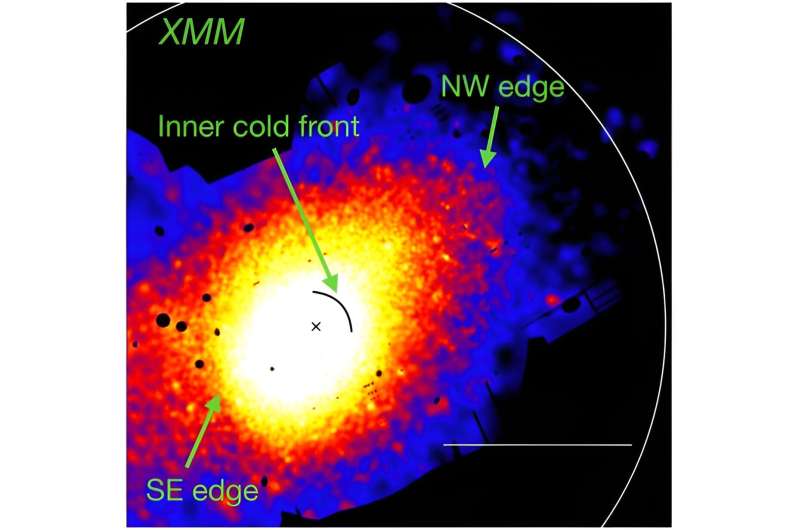September 12, 2023 report
This article has been reviewed according to Science X's editorial process and policies. Editors have highlighted the following attributes while ensuring the content's credibility:
fact-checked
preprint
trusted source
proofread
Two large cold fronts detected in the galaxy cluster Abell 3558

Astronomers from the University of Alabama in Huntsville have investigated the galaxy cluster Abell 3558 using ESA's XMM-Newton spacecraft. In their results, they detected two large-scale sloshing cold fronts in the outskirts of this cluster. The finding was reported in a paper published August 30 on the pre-print server arXiv.
Galaxy clusters contain up to thousands of galaxies bound together by gravity. They are the largest known gravitationally bound structures in the universe, and could serve as excellent laboratories for studying galaxy evolution and cosmology.
At a redshift of 0.048, Abell 3558 is one of the clusters in the Abell 3558 cluster complex located in the Shapley Supercluster. It has a mass of about 980 trillion solar masses and a radius of some 5.2 million light years.
Previous observations of Abell 3558 have found a cold front at a distance of approximately 320,000 light years to the north-west of the cluster's core. In general, the so-called cold fronts are sharp surface brightness discontinuities observed in X-ray images, where the drop of the surface brightness and gas density is accompanied by a jump in the gas temperature, with the denser region colder than the more rarefied region.
The cold front detected in Abell 3558 is assumed to be due to large-scale sloshing, induced by a passage of a small galaxy group, likely SC 1327–312, or by an off-axis merger with a more massive system. A team of astronomers led by Mohammad Mirakhor has analyzed archival XMM-Newton images of Abell 3558 in order to shed more light on this cold front, what resulted in the discovery of two new such features.
The researchers identified two abrupt surface brightness discontinuities at large-scale radii outside the core of Abell 3558 that have not been reported previously. One of them is located about 2 million light years from the cluster core to the south-east and the other is situated approximately 4 million light years from the cluster core to the north-west.
The spectral analysis confirmed that these two discontinuities are in fact large-scale cold fronts. Based on the collected data, the astronomers estimate that the cold front in the south-east direction is about 8.5 billion years old.
The discovery made by Mirakhor's team makes Abell 3558 one of only a few galaxy clusters that host three or more cold fronts. Moreover, the outermost cold front turned out to be one of the most distant cold fronts ever observed in a galaxy cluster, being located at a greater distance from the core than most of the large-scale sloshing cold fronts observed in galaxy clusters.
According to the authors of the paper, their discovery suggests that sloshing can extend well beyond the cooling radius of a galaxy cluster, what means that it is a cluster-wide phenomenon.
More information: M. S. Mirakhor et al, Two large-scale sloshing cold fronts in the outskirts of the galaxy cluster Abell 3558, arXiv (2023). DOI: 10.48550/arxiv.2308.16222
Journal information: arXiv
© 2023 Science X Network





















